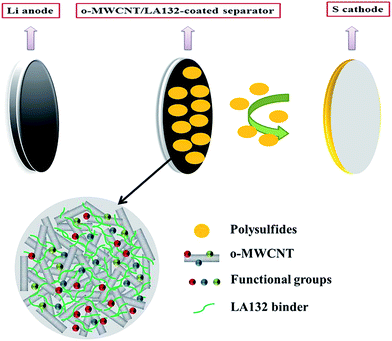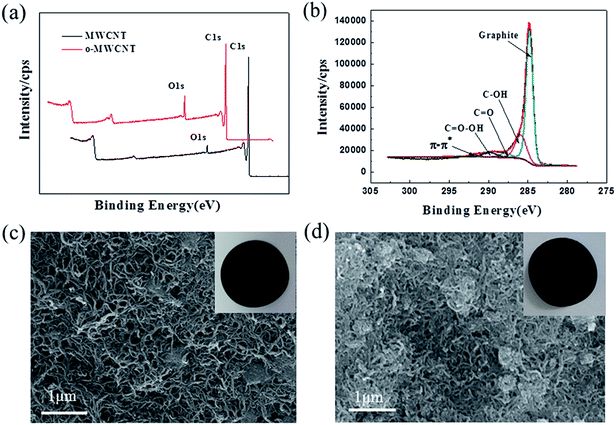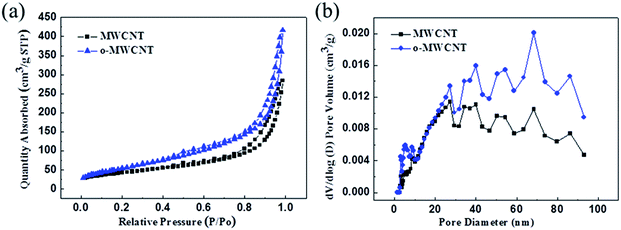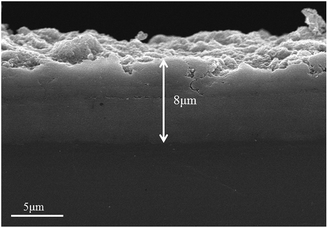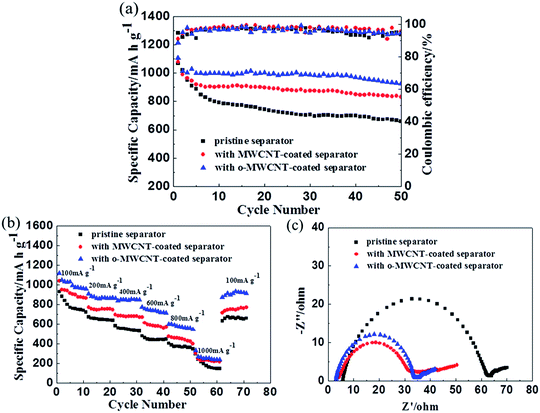Oxidized multiwall carbon nanotube modified separator for high performance lithium–sulfur batteries with high sulfur loading†
Xing Chengab,
Weikun Wang*b,
Anbang Wangb,
Keguo Yuanb,
Zhaoqing Jinb,
Yusheng Yangb and
Xiuying Zhao*a
aDepartment of Material Science and Engineering, Beijing University of Chemical Technology, Beijing 100029, China. E-mail: zhaoxy@mail.buct.edu.cn
bMilitary Power Sources Research and Development Center, Research Institute of Chemical Defense, Beijing 100191, China. E-mail: wangweikun2002@163.com; Fax: +86-10-66748499; Tel: +86-10-66705840
First published on 8th September 2016
Abstract
Recently, researchers have demonstrated that a thin conductive coating on a separator toward the cathode side of lithium–sulfur (Li–S) batteries can improve their electrochemical performance significantly. However, their experimental data are mostly based on cathodes with low sulfur mass loading, while the practical application of Li–S cells requires cathodes with high sulfur loading (≥4 mg cm−2) and high sulfur content (≥70 wt%). Thus, research on the effects of such coatings on Li–S cells with high sulfur loading is essential. Herein, we demonstrate the effectiveness of an oxidized multiwall carbon nanotube (o-MWCNT) coating (0.4 mg cm−2) for improving the electrochemical performance of cathodes with sulfur loading of 5.0 mg cm−2. Due to the physical and chemical trapping of polysulfides, efficient electron conduction and fast ion transport induced by the coating, the fabricated Li–S batteries show dramatically improved specific discharge capacities of up to 925 mA h g−1 (the areal capacity of the cathode is 4.6 mA h cm−2) at a current density of 100 mA g−1 after 50 cycles; they also show good rate performance.
Introduction
With the increasing demand for high-capacity rechargeable batteries for portable, transportation, and stationary storage applications, lithium–sulfur batteries have attracted much attention due to their high theoretical capacity (1672 mA h g−1) and energy density (2600 W h kg−1), which is an order of magnitude higher than that of current Li-ion batteries.1–3 Moreover, their low cost and environmental friendliness make lithium–sulfur batteries competitive as next-generation batteries.3,4 Despite these advantages, there are some drawbacks hindering the commercialization of Li–S batteries: (i) the insulating nature of sulfur and its discharge products (Li2S2/Li2S), (ii) the large volume changes of active materials during the discharge/charge processes and (iii) severe shuttle effects. The insulating nature of sulfur and lithium sulfides leads to low active material utilization and a decrease in discharge capacity. The second challenge involves a volume expansion of 79.2% during full lithiation from S to Li2S, resulting in the pulverization of active materials and capacity decay. The third challenge is the shuttle effect, where the intermediate polysulfides (Li2Sx, 4 ≤ x ≤ 8) produced during the discharge/charge processes dissolve in the organic electrolyte and are reduced to lower-order polysulfides at the interface of the lithium anode, followed by migration back to the cathode, where they may be reoxidized. The polysulfide shuttle occurs repeatedly, resulting in loss of the active materials and low coulombic efficiency in Li–S batteries.5–7In order to overcome these scientific challenges, tremendous efforts have been made to improve the electrochemical performance of Li–S batteries by embedding sulfur in conductive polymers8,9 or in carbon with various morphologies, including microporous carbon,10,11 carbon nanotubes12,13 and functionalized graphenes.13,14 Additionally, other effective studies have been conducted on the electrolytes,15,16 separators17–19 and binders20,21 used in Li–S batteries. Recently, modification of the separator in Li–S cells has attracted much attention from researchers because it results in notable improvements in electrochemical performance; the modified separators provide a conductive coating layer between the cathode and separator for improving the rate capability and the cycle life of Li–S cells.22–29 This coating can facilitate electron or ion transport, enhance electrolyte uptake and suppress polysulfide migration by trapping the dissolved polysulfides. Arumugam Manthiram's group has demonstrated the effectiveness of such coatings using different lightweight, porous and conductive materials, including polyethylene glycol-supported microporous carbon,22 ultra-lightweight MWCNT,23 carbonized eggshell membrane,24 etc.25 Other researchers have also definitely demonstrated this concept through their own studies, such as permselective graphene oxide membrane,26 a polydopamine coated separator,27 a MWCNT@PEG-modified separator28 and an Al2O3 coated porous separator.29 These approaches have significantly addressed the original scientific challenges of Li–S batteries; however, these experimental data are mostly based on cathodes with low sulfur loading (1 to 2 mg cm−2), while the application of Li–S cells requires cathodes with high sulfur loading (≥4 mg cm−2) and high sulfur content (≥70 wt%). Our group has been committed to the study of applied Li–S cells for many years; we have successfully prepared cathodes with high sulfur mass loading (≥5 mg cm−2) and high sulfur content (≥70 wt%) which have been assembled into Li–S cells and show high capacities (≥1000 mA h g−1).9,20,21,30–32 In this paper, the effects of the separator coating on cathodes with high sulfur mass loading are studied.
To study the effects of coatings on cathodes with high mass loadings of sulfur, we prepared sulfur cathodes with a sulfur content of 72 wt%; the mass loading of sulfur is 5.0 mg cm−2. A feasible and practical composite separator with a polysulfide trap attached to the cathode-facing side of a Celgard polypropylene separator has also been presented. As Fig. 1 shows, the polysulfide trap consists of oxidized multiwall carbon nanotubes (o-MWCNTs) and an acrylonitrile copolymer binder (LA132). In consideration of the high loading of active material on the cathodes, MWCNTs were chosen as the carbon coating because they can store more electrolytes than other microporous carbons; this property ensures that the active material of the thick cathodes can be activated effectively during the cycles.23,25,33 The flexible and robust PP membrane cooperates with the LA132 binder to minimize the weight and thickness of the o-MWCNT coating and enhance its mechanical strength.22 The carbon coatings in this paper all contain the LA132 binder unless otherwise mentioned. The MWCNTs were oxidized to improve their dispersibility in water, forming a homogeneous sol and enabling uniform coating. Additionally, the oxygen-containing functional groups also suppress the diffusion of polysulfides by chemical trapping.26,34 The weight of the coating is 0.4 mg cm−2; if this is included in the calculation of the active material content, the cell utilizing the o-MWCNT-coated separator retains a sulfur content of 67%, achieving reasonable sulfur loading in the Li–S cells.
Experimental
Materials preparation
MWCNTs (5.0 g) (Nanolab, Inc.) were refluxed in a mixture of concentrated nitric acid and sulfuric acid with a 1![[thin space (1/6-em)]](https://www.rsc.org/images/entities/char_2009.gif) :
:![[thin space (1/6-em)]](https://www.rsc.org/images/entities/char_2009.gif) 3 volume ratio for 4 h to remove amorphous carbon and form oxygen-containing groups on the MWCNT surface. The acid-treated MWCNTs were filtered using a vacuum filtration system (Millipore, pore size ∼0.22 um) and washed thoroughly with deionized water until the pH became neutral, followed by drying at 60 °C in a vacuum oven for 24 h. Next, the dried oxidized MWCNTs (o-MWCNTs) were mixed with LA132 (15 wt%) in a mass ratio of 8
3 volume ratio for 4 h to remove amorphous carbon and form oxygen-containing groups on the MWCNT surface. The acid-treated MWCNTs were filtered using a vacuum filtration system (Millipore, pore size ∼0.22 um) and washed thoroughly with deionized water until the pH became neutral, followed by drying at 60 °C in a vacuum oven for 24 h. Next, the dried oxidized MWCNTs (o-MWCNTs) were mixed with LA132 (15 wt%) in a mass ratio of 8![[thin space (1/6-em)]](https://www.rsc.org/images/entities/char_2009.gif) :
:![[thin space (1/6-em)]](https://www.rsc.org/images/entities/char_2009.gif) 2 in deionized water and isopropyl alcohol (IPA) with a 3
2 in deionized water and isopropyl alcohol (IPA) with a 3![[thin space (1/6-em)]](https://www.rsc.org/images/entities/char_2009.gif) :
:![[thin space (1/6-em)]](https://www.rsc.org/images/entities/char_2009.gif) 1 volume proportion, then stirred for 10 h to ensure equable dispersion of the mixed materials. For comparison, a slurry of untreated MWCNTs with the same amount of LA132 binder was prepared by the same procedure. Then, the slurries were coated onto one side of a Celgard 2325 separator by the tape casting method via an automatic film applicator (1132N, Sheen) equipped with a standard number 1 blade. After drying, both the coatings (0.4 mg cm−2) formed polysulfide traps with thicknesses of 8 um attached to the Celgard 2325 separator.
1 volume proportion, then stirred for 10 h to ensure equable dispersion of the mixed materials. For comparison, a slurry of untreated MWCNTs with the same amount of LA132 binder was prepared by the same procedure. Then, the slurries were coated onto one side of a Celgard 2325 separator by the tape casting method via an automatic film applicator (1132N, Sheen) equipped with a standard number 1 blade. After drying, both the coatings (0.4 mg cm−2) formed polysulfide traps with thicknesses of 8 um attached to the Celgard 2325 separator.
The sulfur composite materials were prepared as in our previous papers.9,20,32 1.0 g acetylene black was dispersed in ethanol aqueous solution and ultrasonically treated, forming a homogeneous black aqueous dispersion. Then, 0.3 g aniline monomer, 2 mL phosphoric acid and 50 mL 0.1 M (NH4)2S2O8 aqueous solution were slowly added to the above solution successively. After this addition, the mixture was allowed to react for 2.5 h under vigorous stirring, affording C–PANI. Next, 200 mL 1.0 M Na2S solution, 200 mL 0.5 M Na2SO3 solution and 20 mL H2SO4 were simultaneously added dropwise to the above C–PANI solution, and the mixture was allowed to react for 20 min under continuous magnetic stirring; the C–PANI/S composite was then filtered and washed repeatedly with deionized water. Finally, 1.0 g of the obtained C–PANI/S composite was dispersed in a tris–HCl (pH = 8.5) dopamine (2.0 g L−1, 1 L) solution under stirring, then polymerized for 2 h to form the PDA-coated composite, CPANI/S@PDA. The C–PANI/S@PDA composite was collected by filtration, washed repeatedly with water and dried in a vacuum oven at 60 °C for 24 h. The sulfur content of the composite materials is as high as 90 wt% as determined by TGA (Fig. S1†).
Materials characterization
X-ray photoelectron spectroscopy (XPS) spectra of pristine and multiwall carbon nanotubes functionalized with acids were obtained using a spectrophotometer (VG Scientific ESCALAB 210) with a microfocus monochromator Al-Kα X-ray source (hν = 1486.68 eV). The degree of oxidation was determined by elemental analysis using an Elementar Vario EL III instrument (Heraeus). The morphologies of the modified separator and the cathodes before and after cycling were investigated using electron microscopy (SEM, BCPCAS4800). The cycled cathodes were washed with DOL and DME thoroughly in a glove box. The amount of sulfur in the sulfur composite was determined by thermogravimetric (TG) analysis using a Perkin-Elmer Thermogravimetric Analyzer (TGA) from 30 °C to 500 °C under nitrogen at a fixed heating rate of 10 °C min−1.Electrochemical measurements
The sulfur cathodes were prepared by a conventional slurry-coating method with a doctor blade. The cathode slurry was prepared by mixing sulfur composite materials (90 wt%, sulfur), acetylene black, and LA132 binder in a weight ratio of 80![[thin space (1/6-em)]](https://www.rsc.org/images/entities/char_2009.gif) :
:![[thin space (1/6-em)]](https://www.rsc.org/images/entities/char_2009.gif) 10
10![[thin space (1/6-em)]](https://www.rsc.org/images/entities/char_2009.gif) :
:![[thin space (1/6-em)]](https://www.rsc.org/images/entities/char_2009.gif) 10 in deionized water and n-propyl alcohol solution. Then, the slurry was spread onto aluminum foil (20 um). After drying at 60 °C under vacuum for 24 h, the electrode disks (d−1 4 mm) were punched, tableted and weighed. The thickness of the electrode was 130 um and the sulfur loading in each electrode was about 5.0 mg cm−2 (Fig. S2†).
10 in deionized water and n-propyl alcohol solution. Then, the slurry was spread onto aluminum foil (20 um). After drying at 60 °C under vacuum for 24 h, the electrode disks (d−1 4 mm) were punched, tableted and weighed. The thickness of the electrode was 130 um and the sulfur loading in each electrode was about 5.0 mg cm−2 (Fig. S2†).
The Li–S cells were assembled with CR2025 coin-type cells with a sulfur electrode, o-MWCNT-coated separator, lithium foil anode and 1.0 M lithium bis(trifluoromethane sulfonyl)imide (LiTFSI, 99.5%, Aldrich) in a solvent mixture of 1,3-dioxolane and 1,2-dimethoxyethane (1![[thin space (1/6-em)]](https://www.rsc.org/images/entities/char_2009.gif) :
:![[thin space (1/6-em)]](https://www.rsc.org/images/entities/char_2009.gif) 1 by volume) containing 0.1 M LiNO3 as the electrolyte in an argon-filled glove box in which the oxygen and water contents were less than 1 ppm.
1 by volume) containing 0.1 M LiNO3 as the electrolyte in an argon-filled glove box in which the oxygen and water contents were less than 1 ppm.
The galvanostatic charge/discharge tests were carried out at various current densities in the potential range of 1.7 V to 2.8 V using a LAND CT2001A multi-channel battery test system at room temperature. The specific capacity was calculated based on the total mass of active material. Electrochemical impedance spectroscopy measurements were conducted using a CHI1660D electrochemical workstation. EIS measurements were carried out at open-circuit potential in the frequency range from 105 to 0.01 Hz with a perturbation amplitude of 5 mV.
Results and discussion
XPS analysis demonstrates (Fig. 2a) that the oxygen content of the o-MWCNTs is greater than that of untreated MWCNTs. Fig. 2b shows that the oxygen-containing groups of the o-MWCNTs can be assigned to three components: a peak at 285.9 eV for ether-like groups (C–O); a peak at 287.8 eV for carbonyl groups (C![[double bond, length as m-dash]](https://www.rsc.org/images/entities/char_e001.gif) O); and a peak at 289.8 eV for carboxyl groups (C
O); and a peak at 289.8 eV for carboxyl groups (C![[double bond, length as m-dash]](https://www.rsc.org/images/entities/char_e001.gif) O–OH). The results of the elemental analysis show that the oxygen content increases from 0.6 wt% of MWCNTs to 5.9 wt% of o-MWCNTs. As is well known, MWCNTs have a strong tendency to agglomerate because of their nanosize and their respective surface energies. Meanwhile, due to the presence of functional groups such as carboxylates, o-MWCNTs can be dispersed well in H2O or ethanol solvent to form a homogeneous sol. The insert photographs in Fig. 2c and d show images of the MWCNT-coated separator and the o-MWCNT-coated separator, respectively. It is easy to see that the o-MWCNT coating is more uniform than the MWCNT coating. Additionally, we can see from the SEM images in Fig. 2c and d that the o-MWCNT coating is denser than the MWCNT coating, which is due to the cutting of the carbon nanotubes by the oxidation treatment. The pore structures of the MWNCTs and o-MWCNTs were evaluated by nitrogen adsorption–desorption isotherm measurements. As shown in Fig. 3, the amounts of mesopores and macropores in the o-MWCNTs are significantly greater. Also, the surface area and the pore volume of the o-MWCNTs increase from 149.28 m2 g−1 and 0.44 cm3 g−1 to 185.80 m2 g−1 and 0.65 cm3 g−1, respectively. Thus, the uniform coating and the mass of pores in o-MWCNTs enhance their ability to physically trap polysulfides compared to pristine MWCNTs. At the same time, the carboxyl groups can act as ion-hopping sites of positively charged species (Li+) and prevent the transportation of polysulfides due to electrostatic interactions.26 These physical and chemical trapping effects of the separator coating can effectively restrain the diffusion of polysulfides during cycling and improve the performance of the cells.
O–OH). The results of the elemental analysis show that the oxygen content increases from 0.6 wt% of MWCNTs to 5.9 wt% of o-MWCNTs. As is well known, MWCNTs have a strong tendency to agglomerate because of their nanosize and their respective surface energies. Meanwhile, due to the presence of functional groups such as carboxylates, o-MWCNTs can be dispersed well in H2O or ethanol solvent to form a homogeneous sol. The insert photographs in Fig. 2c and d show images of the MWCNT-coated separator and the o-MWCNT-coated separator, respectively. It is easy to see that the o-MWCNT coating is more uniform than the MWCNT coating. Additionally, we can see from the SEM images in Fig. 2c and d that the o-MWCNT coating is denser than the MWCNT coating, which is due to the cutting of the carbon nanotubes by the oxidation treatment. The pore structures of the MWNCTs and o-MWCNTs were evaluated by nitrogen adsorption–desorption isotherm measurements. As shown in Fig. 3, the amounts of mesopores and macropores in the o-MWCNTs are significantly greater. Also, the surface area and the pore volume of the o-MWCNTs increase from 149.28 m2 g−1 and 0.44 cm3 g−1 to 185.80 m2 g−1 and 0.65 cm3 g−1, respectively. Thus, the uniform coating and the mass of pores in o-MWCNTs enhance their ability to physically trap polysulfides compared to pristine MWCNTs. At the same time, the carboxyl groups can act as ion-hopping sites of positively charged species (Li+) and prevent the transportation of polysulfides due to electrostatic interactions.26 These physical and chemical trapping effects of the separator coating can effectively restrain the diffusion of polysulfides during cycling and improve the performance of the cells.
Ten pieces of separator disk were weighed to identify the mass of the coating film; the statistical results show that the mass loadings of the MWCNT coating and o-MWCNT coating are approximately 0.4 mg cm−2. Fig. 4 shows a cross-sectional SEM observation of the original o-MWCNT-coated separator. We can see that the thickness of the coating is about 8 um. The sulfur loading is 5.0 mg cm−2 with a content of 72 wt% in the cathode; thus, even if the weight of the o-MWCNT coating is included in the calculation of the active material content, the sulfur content is still as high as 67 wt%, which is higher than most reported work.
To evaluate the electrochemical behavior of the high sulfur content Li–S batteries with the modified separator, coin-type cells were assembled with an o-MWCNT-coated separator, an MWCNT-coated separator and a pristine separator. Fig. 5 shows the discharge/charge curves of the cells utilizing the pristine separator and coated separators during the initial 10 cycles at a current density of 100 mA g−1. The upper discharge plateau at 2.35 V and the lower discharge plateau at 2.05 V represent the reduction from sulfur to long-chain polysulfides (Li2S2, 4 < χ ≤ 8) and from long-chain polysulfides to Li2S2/Li2S, respectively. As Fig. 5 shows, the overlapping discharge curves of cells with the pristine separator demonstrate a constant decline in capacity. Also, the cells with the MWCNT-coated separator exhibit capacity fade during the initial five cycles. However, the cells with the o-MWCNT-coated separator show no severe decline in capacity from the second cycle, which proves there is almost no active material loss when using the o-MWCNT coating. Moreover, the completeness of the overlapping upper discharge plateaus during cycling proves that the o-MWCNT coating on the separator efficiently suppresses polysulfide diffusion and that severe active material loss has not occurred. On the other hand, the initial QH of the cell with the o-MWCNT-coated separator at a current density of 100 mA g−1 is 333 mA h g−1, approaching 79.5% of the theoretical value, which is larger than that of the cell with the MWCNT-coated separator (288 mA h g−1) and that with the pristine separator (251 mA h g−1). These results further indicate that severe polysulfide diffusion has been suppressed by the coating. The end voltage of the upper discharge plateau can represent the degree of electrode polarization. A lower end voltage represents more serious electrode polarization, which usually occurs in Li–S cells with high sulfur loading. As Fig. 5 shows, the normal end voltage of the cells with the MWCNT-coated separator and the o-MWCNT-coated separator is 2.05 V, while that of the cells with the pristine separator is 2.0 V, which demonstrates that the latter undergoes serious electrode polarization. The difference may be ascribed to the fact that a carbon coating on the separator stabilizes the electrolyte within the cathode region and leads to fast ion migration. In addition, the conductive coating acts as an upper current corrector, which also plays a part in decreasing the electrode polarization.
 | ||
| Fig. 5 Discharge/charge curves of Li–S cells with (a) pristine separator, (b) MWCNT-coated separator and (c) o-MWCNT-coated separator. | ||
Fig. 6a shows the cycle performances of Li–S cells with the o-MWCNT-coated separator, MWCNT-coated separator and pristine separator at a current density of 100 mA g−1. The cell with the o-MWCNT-coated separator exhibits a high initial capacity of 1105 mA h g−1. This is a slight increase compared to the capacities of the cells with the MWCNT-coated separator (1077 mA h g−1) and the pristine separator (1069 mA h g−1). After 50 cycles, the reversible discharge capacities of the cells with the o-MWCNT-coated separator and MWCNT-coated separator are 925 mA h g−1 and 832 mA h g−1, respectively, while that of the cell with the pristine separator is 668 mA h g−1. Thus, the cells with coatings on the separators demonstrate superior cyclability to the cell with the pristine separator, which demonstrates that the carbon coatings on the separator definitely improve the cycle performance of Li–S cells with high sulfur loading. Additionally, the o-MWCNT-coated separator mitigates capacity fading compared with the MWCNT-coated separator; the average coulombic efficiency of the cell can reach 94.6% over 50 cycles. Hence, the cell with the o-MWCNT-coated separator shows a more significant capability of trapping polysulfides than the cell with the MWCNT-coated separator. The rate performances of the cells with the above three separators are shown in Fig. 6b. For the cell with the o-MWCNT-coated separator, the reversible discharge capacities are respectively 960, 867, 848, 715, 546, and 238 mA h g−1 at current densities of 100, 200, 400, 600, 800 and 1000 mA g−1, which are higher than the respective values of 865, 745, 672, 572, 402, and 217 mA h g−1 of the cell with the MWCNT-coated separator at the same rate. The cells with carbon-coated separators show a notable advantage in rate performance compared with the cell with the pristine separator, whose respective discharge capacities are 727, 639, 533, 448, 348 and 148 mA h g−1 at the same rate. Thus, the o-MWCNT-coated separator greatly improves the rate capability of Li–S cells. The stable cyclability and excellent rate capability of the cell with the o-MWCNT coated separator may be due to the excellent electron conductivity, the strengthened physical localization of the polysulfides and the chemical barrier effect with carboxyl groups by coulombic interactions.
The electrochemical impedance spectroscopy (EIS) data of the cells with different separators before cycling are shown in Fig. 6c. It can be seen from Fig. 6c that the Nyquist plots of the cells consist of semicircles at high frequency and medium frequencies and inclined lines at low frequency. The intercepts at high frequency on the real axis represent the ohmic resistance of the electrodes and electrolytes. The semicircles at high to medium frequency are associated with the charge transfer resistance of Li-ion insertion. In addition, the inclined lines at low frequency correspond to Li-ion diffusion impedance within the cathodes. The data indicates that the electrochemical impedances of the cell with the o-MWCNT-coated separator are close to those of the cell with the MWCNT-coated separator; also, both cells show lower resistances than the cell with the pristine separator. These results prove that the cells with carbon-coated separators can decrease the ohmic resistance and the charge transfer resistance of Li–S cells, which are in agreement with the results of the cycle and rate performance tests.
Scanning electron microscopy (SEM) images and the corresponding energy-dispersive X-ray spectroscopy (EDX) spectra of the o-MWCNT-coated separator before and after 50 cycles at a current density of 100 mA g−1 are shown in Fig. 7. As is shown in Fig. 7a, before cycling, the o-MWCNTs form porous micro-sized clusters that are closely attached to the Celgard separator; EDX inspection of the o-MWCNT-coated separator shows that no elemental sulfur is detected. The SEM inspection of Fig. 7b shows that the trapped active materials (the elemental sulfur signals, marked as green) are distributed uniformly in the carbon matrix (marked as red) after cycling, indicating the excellent interception and absorption effects of the porous o-MWCNT clusters. We can see that the signals of elemental carbon remain strong and distinguishable, and the signals of elemental sulfur show no dense spots; this demonstrates that the interwoven conductive carbon nanotubes can transfer the electrons to the trapped active materials and promote their reaction, avoiding the formation of nonconductive agglomerations. Moreover, the cross-sectional SEM image of the cycled o-MWCNT-coated separator (Fig. S3†) shows strong sulfur signals in the elemental mapping result, which further proves that the o-MWCNT coating effectively suppresses the diffusion of polysulfides. Additional evidence of this outstanding polysulfide-trapping capacity can be found in the SEM image of the cycled Li anode in the cell utilizing the o-MWCNT-coated separator. As is shown in Fig. S4a,† the surface of the cycled Li anode in the cell employing the pristine separator is rough, with visible Li dendrites or Li2S/Li2S precipitates; this is mostly attributed to the migration of polysulfides between the cathode and the anode. When the o-MWCNT-coated separator was employed, the surface of the cycled Li anode became smooth, with few redeposited insulating agglomerates (Fig. S4b†). This change in the cycled Li anode shows that the o-MWCNT coating prevents the diffusion of polysulfides.
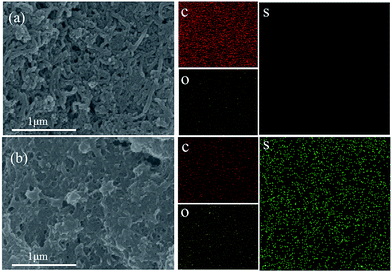 | ||
| Fig. 7 SEM observations and elemental mappings of the o-MWCNT-coated separator before (a) and after (b) 50 cycles at a current density of 100 mA g−1. | ||
Judging from the above results, we can conclude that the application of the o-MWCNT-coated separator has a good effect on the electrochemical performance of Li–S cells with high sulfur loading. This is due to its efficient electron conduction, fast ion transport, high electrolyte retention, strengthened physical localization of polysulfides and the chemical barrier effect with carboxyl groups by coulombic interactions. Thus, the cell with the o-MWCNT-coated separator shows stable cycle ability and excellent rate performance. It is notable that the separator coating functions well with the cathode with high sulfur loading. On the one hand, the extra addition of electrochemically inactive products will not greatly decrease the overall energy density of Li–S cells. On the other hand, the porous carbon coating has the ability to absorb electrolyte and increases the demand for the electrolyte; therefore, it is necessary to increase the sulfur loading in the cathode to maintain a high active material proportion in the whole cell, which is a necessary condition for achieving high energy density Li–S cells. Hence, the efficient separator coating in conjunction with a high sulfur loading cathode can lead to high energy density and excellent cycle and rate performances; this will promote the commercial feasibility of Li–S cells.
Conclusions
In summary, an o-MWCNT-coated separator successfully integrated bundled polysulfide filter with a polypropylene separator component in lithium–sulfur batteries containing cathodes with high sulfur mass loading, offering improvements in both cycle and rate performances. The cells with this modified separator exhibit an initial discharge capacity of 1105 mA h g−1 after 50 cycles; the discharge capacity remains at 925 mA h g−1 (the areal capacity of the cathode is 4.6 mA h cm−2), demonstrating high capacity retention and reversibility. Additionally, the cell displays excellent rate performance at current densities from 100 mA h g−1 to 1000 mA h g−1. The improved cycle and rate performances can be ascribed to three major factors: (i) the o-MWCNT coating physically and chemically traps the migrating polysulfides, (ii) the conductive polysulfide trap, as an upper current collector, reutilizes and reactivates the immobilize active materials, and (iii) the porous o-MWCNT coating restores the electrolyte and provides channels to facilitate ion transport. Thus, it can be concluded that this o-MWCNT-coated separator can be successfully applied in lithium–sulfur batteries with cathodes with high sulfur loading, while offering some enhancements; this further promotes the commercial application of lithium–sulfur batteries.Acknowledgements
This work was financially supported by the Fund from Beijing Science and Technology Project.Notes and references
- B. Scrosati and J. Garche, J. Power Sources, 2010, 195, 2419–2430 CrossRef CAS
.
- P. G. Bruce, S. A. Freunberger, L. J. Hardwick and J.-M. Tarascon, Nat. Mater., 2012, 11, 19–29 CrossRef CAS PubMed
.
- A. Manthiram, Y. Fu and Y.-S. Su, Acc. Chem. Res., 2012, 46, 1125–1134 CrossRef PubMed
.
- X. Ji and L. F. Nazar, J. Mater. Chem., 2010, 20, 9821–9826 RSC
.
- C. Barchasz, J.-C. Leprêtre, F. Alloin and S. Patoux, J. Power Sources, 2012, 199, 322–330 CrossRef CAS
.
- S. S. Zhang, J. Power Sources, 2013, 231, 153–162 CrossRef CAS
.
- Y. V. Mikhaylik and J. R. Akridge, J. Electrochem. Soc., 2004, 151, A1969–A1976 CrossRef CAS
.
- J. Wang, J. Yang, J. Xie and N. Xu, Adv. Mater., 2002, 14, 963–965 CrossRef CAS
.
- M. Wang, W. Wang, A. Wang, K. Yuan, L. Miao, X. Zhang, Y. Huang, Z. Yu and J. Qiu, Chem. Commun., 2013, 49, 10263–10265 RSC
.
- J. Balach, T. Jaumann, M. Klose, S. Oswald, J. Eckert and L. Giebeler, J. Power Sources, 2016, 303, 317–324 CrossRef CAS
.
- N. Jayaprakash, J. Shen, S. S. Moganty, A. Corona and L. A. Archer, Angew. Chem., 2011, 123, 6026–6030 CrossRef
.
- L. Wang, Y. Zhao, M. L. Thomas and H. R. Byon, Adv. Funct. Mater., 2014, 24, 2248–2252 CrossRef CAS
.
- C. Tang, Q. Zhang, M. Q. Zhao, J. Q. Huang, X. B. Cheng, G. L. Tian, H. J. Peng and F. Wei, Adv. Mater., 2014, 26, 6100–6105 CrossRef CAS PubMed
.
- H. Wang, Y. Yang, Y. Liang, J. T. Robinson, Y. Li, A. Jackson, Y. Cui and H. Dai, Nano Lett., 2011, 11, 2644–2647 CrossRef CAS PubMed
.
- J. Zhaoqing, X. Kai and H. Xiaobin, Acta Chim. Sin., 2014, 72, 11–20 CrossRef
.
- X. B. Cheng, R. Zhang, C. Z. Zhao, F. Wei, J. G. Zhang and Q. Zhang, Adv. Sci., 2015, 201500213 Search PubMed
.
- Z. Jin, K. Xie, X. Hong, Z. Hu and X. Liu, J. Power Sources, 2012, 218, 163–167 CrossRef CAS
.
- Z. Jin, K. Xie and X. Hong, RSC Adv., 2013, 3, 8889–8898 RSC
.
- J.-Q. Huang, Q. Zhang, H.-J. Peng, X.-Y. Liu, W.-Z. Qian and F. Wei, Energy Environ. Sci., 2014, 7, 347–353 CAS
.
- F. Zeng, W. Wang, A. Wang, K. Yuan, Z. Jin and Y.-s. Yang, ACS Appl. Mater. Interfaces, 2015, 7, 26257–26265 CAS
.
- J. Sun, Y. Huang, W. Wang, Z. Yu, A. Wang and K. Yuan, Electrochim. Acta, 2008, 53, 7084–7088 CrossRef CAS
.
- S.-H. Chung and A. Manthiram, Adv. Mater., 2014, 26, 7352–7357 CrossRef CAS PubMed
.
- S.-H. Chung and A. Manthiram, J. Phys. Chem. Lett., 2014, 5, 1978–1983 CrossRef CAS PubMed
.
- S. H. Chung and A. Manthiram, Adv. Mater., 2014, 26, 1360–1365 CrossRef CAS PubMed
.
- C.-H. Chang, S.-H. Chung and A. Manthiram, J. Mater. Chem. A, 2015, 3, 18829–18834 CAS
.
- J.-Q. Huang, T.-Z. Zhuang, Q. Zhang, H.-J. Peng, C.-M. Chen and F. Wei, ACS Nano, 2015, 9, 3002–3011 CrossRef CAS PubMed
.
- Z. Zhang, Z. Zhang, J. Li and Y. Lai, J. Solid State Electrochem., 2015, 19, 1709–1715 CrossRef CAS
.
- G. Wang, Y. Lai, Z. Zhang, J. Li and Z. Zhang, J. Mater. Chem. A, 2015, 3, 7139–7144 CAS
.
- Z. Zhang, Y. Lai, Z. Zhang, K. Zhang and J. Li, Electrochim. Acta, 2014, 129, 55–61 CrossRef CAS
.
- C. Zhang, W. Wang, A. Wang, K. Yuan, Y. Yang and Y. Lu, J. Electrochem. Soc., 2015, 162, A1067–A1071 CrossRef CAS
.
- L.-X. Miao, W.-K. Wang, A.-B. Wang, K.-G. Yuan and Y.-S. Yang, J. Mater. Chem. A, 2013, 1, 11659–11664 CAS
.
- L. Miao, W. Wang, K. Yuan, Y. Yang and A. Wang, Chem. Commun., 2014, 50, 13231–13234 RSC
.
- Y.-S. Su and A. Manthiram, Chem. Commun., 2012, 48, 8817–8819 RSC
.
- X. Wang, Z. Wang and L. Chen, J. Power Sources, 2013, 242, 65–69 CrossRef CAS
.
Footnote |
| † Electronic supplementary information (ESI) available. See DOI: 10.1039/c6ra14581g |
| This journal is © The Royal Society of Chemistry 2016 |

